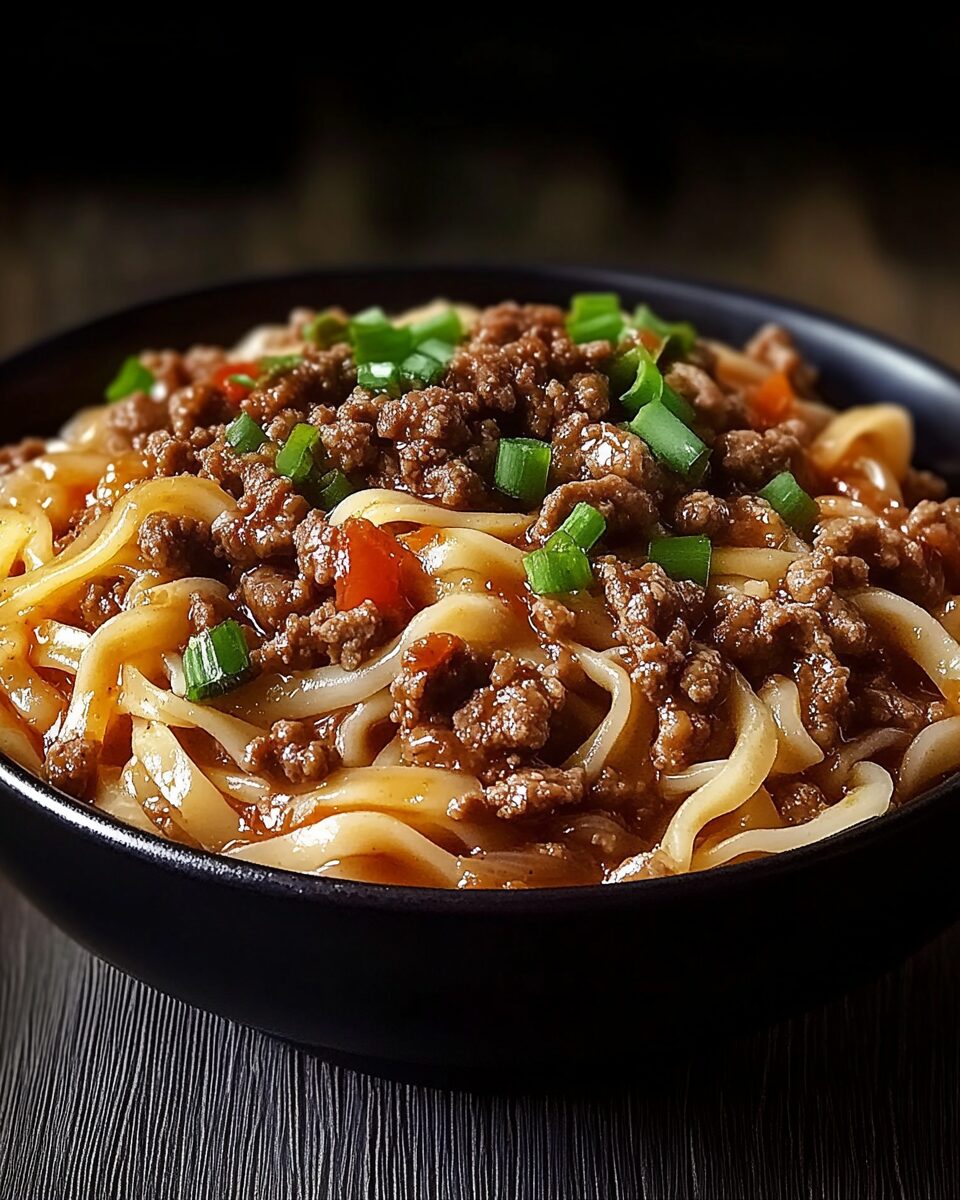The Mongolian Ground Beef Noodles are a quick, hearty, and flavor-packed meal that delivers serious takeout vibes with minimal effort. With its perfectly seasoned ground beef coated in a sweet and garlicky soy sauce, this dish is a true crowd-pleaser. Paired with tender noodles and finished with scallions and sesame seeds, it’s a one-pan wonder that’s perfect for busy weeknights or whenever the craving for bold, Asian-inspired flavors strikes. Easy to prepare and deeply satisfying, this is a go-to recipe to add to your comfort food rotation.
Full Recipe:
Ingredients:
-
8 oz lo mein or spaghetti noodles
-
1 tablespoon sesame oil
-
1 lb ground beef
-
3 cloves garlic, minced
-
1/4 cup brown sugar
-
1/3 cup low-sodium soy sauce
-
1/4 cup beef broth
-
1 tablespoon hoisin sauce
-
1/2 teaspoon ground ginger
-
1 tablespoon cornstarch
-
1/4 cup water
-
3 green onions, sliced
-
1/2 teaspoon red pepper flakes (optional)
-
Sesame seeds for garnish
Directions:
-
Cook noodles according to package instructions. Drain and set aside.
-
In a large skillet, heat sesame oil over medium heat. Add ground beef and cook until browned, breaking it apart with a spatula.
-
Add garlic and sauté for 1 minute until fragrant.
-
In a small bowl, whisk together brown sugar, soy sauce, beef broth, hoisin sauce, and ground ginger. Pour over beef and stir to coat.
-
In another small bowl, mix cornstarch with water. Pour into skillet and stir until sauce thickens, about 2–3 minutes.
-
Add cooked noodles to the skillet and toss to combine with the beef and sauce.
-
Stir in sliced green onions and red pepper flakes (if using).
-
Garnish with sesame seeds before serving.
Prep Time: 10 minutes | Cooking Time: 15 minutes | Total Time: 25 minutes
Kcal: 520 kcal | Servings: 4 servings
Mongolian Ground Beef Noodles: A Flavorful Fusion of East and West
When you’re short on time but craving something hearty and satisfying, few meals come together as beautifully and effortlessly as Mongolian Ground Beef Noodles. This dish is a fusion-style twist on the classic Mongolian beef typically served in Asian-American restaurants. With the use of ground beef, this version simplifies the preparation while still delivering big, bold flavors. Think sweet and savory soy-based sauce, rich umami notes, a hint of garlic, and a silky texture that coats every strand of noodle this is the kind of dish that instantly becomes a weeknight staple.
Whether you’re feeding a hungry family or batch cooking for easy lunches, Mongolian Ground Beef Noodles hits all the right notes. Let’s dive into the origins, flavor profile, customization options, and why this meal deserves a regular spot in your recipe rotation.
The Cultural Inspiration Behind the Dish
Despite its name, Mongolian beef is not a traditional Mongolian dish. It is, in fact, a popular item on the menu of American-Chinese restaurants. The dish draws on Chinese culinary techniques, especially from the stir-fry-heavy traditions of Taiwan, where it is believed to have first gained popularity before migrating to the West.
Mongolian cuisine itself is centered around hearty meats and dairy, better suited to the harsh climates of the steppes, whereas Mongolian beef as we know it in the West is far more influenced by Chinese and Taiwanese flavors: ginger, garlic, soy sauce, hoisin, and green onions are all staples of Chinese cuisine. When combined with noodles another traditional Chinese and pan-Asian staple it forms a complete meal that satisfies on every level.
By using ground beef instead of sliced flank steak, this version brings the flavor of Mongolian beef into a more accessible and budget-friendly territory. It’s a perfect example of how classic dishes can evolve and adapt based on available ingredients and modern needs.
Why Ground Beef?
The choice of ground beef in this recipe is no accident. Ground beef is one of the most versatile, affordable, and quick-cooking proteins available. It browns in minutes, takes on flavors readily, and pairs perfectly with sauces and noodles alike.
While traditional Mongolian beef uses thinly sliced steak (typically flank or sirloin), that method requires marinating, slicing against the grain, and careful searing to avoid overcooking. Ground beef, by contrast, is ideal for busy home cooks who want the same flavor profile in less time. It’s also easier to portion and more forgiving in terms of cooking times, making it suitable for novice cooks and meal preppers alike.
Additionally, the use of ground beef makes the dish more adaptable you can use lean or fatty cuts depending on your dietary preferences, or even substitute it with ground turkey, chicken, pork, or plant-based meat alternatives.
The Signature Sauce: Sweet, Savory, and Umami-Rich
The heart of this dish lies in its sauce a delicate balance of salty soy sauce, sweet brown sugar, earthy hoisin sauce, and aromatic garlic and ginger. This blend is what gives Mongolian Ground Beef Noodles their irresistible flavor. The sauce is rich, but not overpowering. It clings to the noodles and beef beautifully, offering both depth and balance.
Hoisin sauce adds complexity and a touch of fermentation, while beef broth gives the dish a fuller, more rounded mouthfeel. Cornstarch is used to thicken the sauce, creating that signature glossy finish that makes this dish look like it came straight from a restaurant.
For those who like a bit of heat, adding red pepper flakes or even a dash of chili garlic sauce brings a spicy counterpoint to the sweetness of the brown sugar. It’s customizable to any spice tolerance, which makes it a crowd-pleaser.
Pairing and Serving Suggestions
Mongolian Ground Beef Noodles are a complete meal on their own, but you can easily round out your plate with simple sides. A few great pairings include:
-
Steamed or sautéed broccoli – adds a pop of color and crunch
-
Julienned carrots or snap peas – provide sweetness and texture
-
A light Asian cucumber salad – balances the richness with acidity and freshness
-
Fried or steamed dumplings – if you’re serving this at a larger gathering or dinner party
If you’re making this for meal prep, divide it into portions with a side of steamed vegetables for a balanced, reheatable lunch option throughout the week.
For a lighter version, serve the beef and sauce over spiralized zucchini noodles or cauliflower rice. It keeps the flavor but reduces the carbs for those on low-carb or keto diets.
Customization and Dietary Variations
One of the best things about Mongolian Ground Beef Noodles is how easy it is to customize. Whether you’re cooking for dietary restrictions or just want to use what you have on hand, this recipe is endlessly adaptable.
Protein Substitutes
-
Ground turkey or chicken for a lighter version
-
Plant-based ground meat for a vegetarian or vegan twist
-
Diced tofu or tempeh for a soy-based alternative
Noodle Variations
-
Rice noodles for a gluten-free option
-
Ramen noodles for a classic comfort food twist
-
Zoodles or shirataki noodles for low-carb alternatives
Sauce Adjustments
-
Coconut aminos instead of soy sauce for a gluten-free and lower sodium version
-
Add sriracha or chili paste for heat
-
Use honey or maple syrup in place of brown sugar for a more natural sweetness
This recipe is perfect for experimentation and can suit a wide range of diets and preferences.
Storage and Reheating Tips
Mongolian Ground Beef Noodles store well, making them ideal for meal prep. You can refrigerate leftovers in an airtight container for up to 4 days. When reheating, a quick toss in a hot skillet will revive the flavors and texture better than microwaving, though either method works fine.
If you’re planning to freeze it, store the beef and sauce separately from the noodles to avoid mushiness. Simply thaw, reheat, and combine when ready to eat.
The Nutritional Takeaway
Though not a low-calorie dish by design, Mongolian Ground Beef Noodles offer a good balance of macronutrients: protein from the beef, carbohydrates from the noodles, and some fat from the sesame oil and meat. To increase the nutritional value, consider adding vegetables like bell peppers, spinach, or shredded cabbage directly into the skillet during the last few minutes of cooking.
You can also reduce the amount of brown sugar slightly without compromising flavor, especially if your hoisin sauce is on the sweeter side.
For those watching sodium intake, using low-sodium soy sauce and broth makes a big difference. Similarly, lean ground beef or alternative proteins can lower the saturated fat content.
Conclusion:
Mongolian Ground Beef Noodles combine ease, speed, and flavor in a way few recipes do. It’s comfort food with an Asian twist the kind of dish that tastes like it took hours to make, but in reality comes together in under 30 minutes. Whether you’re a college student with a single skillet, a parent trying to feed picky eaters, or just someone who wants to spice up their weekly dinner rotation, this dish checks all the boxes.
Its adaptability is part of what makes it such a winner from the protein to the spice level to the noodle base, you can tweak it a hundred ways without ever getting bored. So next time you’re thinking about takeout, consider giving this homemade version a try. Your taste buds (and your wallet) will thank you.






